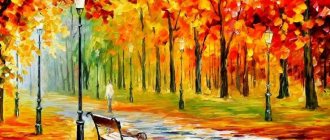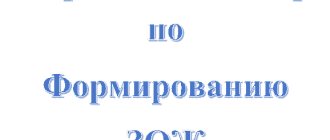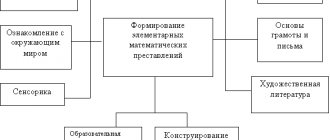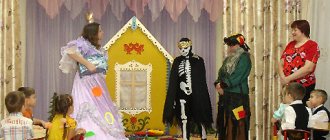Progress of the lesson:
Children enter the hall and greet the guests. Presenter: (draws the children’s attention to the bird). Look, guys, a bird flew to us today. And she brought us something. (Takes the letter and reads it.)
“Dear guys, I know that you love music. I invite you to visit me, to the Land of Musical Instruments. "Skripochka girl."
Well, guys, do we accept the invitation? Then let's take castanets, they will help us on the way. (A voice is heard behind the door: “Wait, wait!” Parsley runs in).
Don't leave without me! Hello! Take me with you! I also love music. Listen to me sing. (sings out of tune)
I am Parsley - well done, There is a bell on the top of my head. I’ll go out, I’ll go out, I’ll dance, I’ll have fun, I’ll make you laugh.
Wait, wait, Petrushka, you're not singing correctly. Let's take Petrushka with us so that he can learn to sing and play different musical instruments from us. Is everyone ready? Let's hit the road! (Children move to the music and tap the rhythm on castanets).
1. walking - music. Shulgina, 2. running into the loose - music. 3. alternate stamping of feet - Russian. adv. chalk. 4. alternately placing the legs on the toes - Russian adv. chalk.
Equipment for classes in kindergarten:
- record player,
- audio cassettes,
- children's musical instruments,
- doll - “conductor”,
- portraits of composers (F. Schubert, J. S. Bach, F. Chopin),
- album with photographs of musical instruments,
- screen,
- sultans.
Repertoire:
- “Dance” by F. Schubert;
- “The Joke” by J. S. Bach;
- “Waltz No. 17” by F. Chopin;
- organ music by J. S. Bach;
- musical and didactic game “Musical Instruments”;
- sedentary game "Orchestra".
____________________________ NOTE - You can buy toys for kindergarten in the specialized store "KINDERGARTEN" - detsad-shop.ru Low prices, discounts for kindergartens and children. committees, delivery!
____________________________
“Musical instruments”. Non-traditional drawing technique
Program content:
1. Cultivate interest in music, respect for musical instruments, the ability to listen, feel music, and experience it.
2. Develop children's creative abilities.
Materials:
a letter from Dunno, a sheet of cardboard, a pencil, gouache, a brush, semolina (for each child), an audio recording of music and musical instruments.
Progress of the lesson
1 part. From the history of musical instruments
Children enter the group and sit on chairs. Calm music sounds.
Educator: Guys, listen, what do you hear now? (Children's answers.)
Do you like music?
Which one? (Children's answers.)
This morning I found a letter from Dunno in my mailbox, let's read it:
(reading the letter)
. Well, guys, let's help Dunno?
Today we are waiting for you on an exciting journey into the world of music. When do you think music and musical instruments appeared? (Children's answers.)
Guys, music originated a long time ago. Even in ancient times, many legends were composed about the origin of music. The ancient Greeks believed that music was given to them by the gods. Scientists, based on research, have established that music appeared in primitive society. For ancient people, it was associated with everyday life. The woman hummed, rocking the children, the shepherds called the flock with the sound of horns. In primitive music there were many onomatopoeias: the songs repeated the sounds of the surrounding world - the cries of wild animals and birds. The main element was rhythm. He helped people perform movements clearly while working. Singers emphasized the rhythm by clapping or stamping their feet. Later, people noticed that flat stones, pieces of wood, and shells made loud sounds when struck. They became the first musical instruments.
Let's play the game "What does it sound like?"
I'll play the recording for you, and you have to guess what musical instrument you hear:
I turn on the audio recording, the children guess what kind of instrument it is (drum, violin, balalaika, pipe).
Do you know where these types of musical instruments came from? (Children's answers.)
Strings - from a hunting bow, winds - from a shell, horn, reed. But the most venerable age belongs, of course, to percussion instruments: they arose among primitive people, who began to accompany their dances with the rhythmic striking of one stone against another. Gradually more advanced musical instruments appeared. It turned out that if you stretch the skin over a hollow wooden or clay object, the sound will become louder and stronger. This is how the ancestors of the drums were born.
Guys, unfortunately Dunno did not know all this, since he was not with us on the trip. Let's draw musical instruments for him as a souvenir and send it by letter.
2 practical part. Drawing with semolina
Take a seat at the tables. You see on them a sheet of cardboard, a pencil, gouache, a brush, glue and semolina on a plate. Now each of you will draw the musical instrument that you want. I remind you of the rules for drawing with semolina:
1. First, draw a drawing on cardboard with a pencil.
2. We outline our drawing with PVA glue.
3. Take semolina and scatter it over the pattern, with glue already applied.
4. When the glue dries a little, you need to shake off the excess semolina.
5. Give a little time for the cereal to stick and paint the drawing using the poking method (on the cereal).
All clear? Then let's get our fingers ready.
Finger game. Dwarves' treat
The gnomes began to invite guests. ( Alluring movements with both hands
.)
The gnomes began to treat the guests. ( Shake hands several times: alternately with the right and then the left hand on top
.)
Each guest got jam. ( The index finger of the right hand “spreads” imaginary jam on the fingers of the left hand: from base to tip
.)
My fingers were glued together by that treat. ( Sequentially, starting with the little fingers, connect the pads of the same fingers of both hands
.)
Palm pressed tightly to palm, ( Accordingly
.)
Guests cannot even take spoons! ( An adult checks how tightly the baby’s palms are “stuck together” and pulls him by the elbows to the sides
.)
Now get started... (children draw).
Well done! Look what wonderful musical instruments you have made. Dunno will really like them.
Reflection
Well, our journey has come to an end. Did you like it? What new did you learn today? (children's answers.)
Now let's dance a little. Stand in a circle.
The children dance to the music “If you like it, then do it this way.”
Getting to know the music tools - lesson for children 4-5 years old
Goal: Development of musical abilities through playing noise instruments. Creation of conditions conducive to increasing the creative activity of children, expanding their musical horizons, awakening interest in all types of musical activities.
Tasks:
Educational: To attract children to perform tasks correctly, to develop sustained attention when completing them. To develop the ability to correctly name noise instruments, play them rhythmically, and listen to each other. Enrich children's vocabulary. Developmental: Improve children's motor activity, coordination of movements and free movement in space. Develop a sense of rhythm, musical memory; With the help of experimental activities, develop imagination and creative imagination. Develop the ability to react to changing parts of music.
Educational: Arouse desire and interest in playing noise instruments. Foster curiosity, independence, and activity when completing tasks.
Methods: Verbal (riddles, conversation). Visual (presentation, noise instruments). Practical (playing with spoons, playing with a tambourine, dancing with rattles, song-dance). Gaming (game with a tambourine, reflection).
Vocabulary work: Introduce the names of noise instruments into the children's active dictionary.
Preliminary work: Learning songs with movements. Playing musical instruments. Learning the dance with rattles. Introducing the outdoor game with a tambourine.
Individual work: Reproduction of rhythmic patterns at the request of the teacher. Encouraging children for completing a task. Encourage inactive children to become active.
Equipment: Multimedia installation. Music Center. Audio recordings. Children's noise instruments: spoons, rattles according to the number of children. Pockets for handouts. Diamonds for use in the game. Chest with non-traditional tools. Posting for reflection.
Techniques: Musical greeting. Departure to the city of musical instruments. Puzzles. Reproduction of rhythmic patterns at the request of the teacher. Outdoor game. Dance. Singing.
Musical repertoire: Communication game “Hello!” Musical and rhythmic warm-up by E.D. Makshantseva. A song with imitation of playing instruments “Let's play and sing.” An outdoor game with a tambourine. R.n.m “Oh, you canopy, my canopy.” Dance with rattles. Song-dance “We will clap our hands...”.
Children enter the hall to the music and stand in a general circle.
COMMUNICATION GAME “HELLO”
Magazine "Musical Palette".
Hello, palms clap - clap - clap Hello, legs - top - top - top Hello, eyes - myrg, myrg, myrg Hello, my nose - pip - pip - peep Hello, ears - wow - wow - wow Hello, cheeks - splash - splash - splash Hello, sponges - smack - smack - smack Hello, children, hello!
Musical director: Guys, do you want to go on an excursion to the Town of Musical Instruments?
Children's answers.
Fine. To go on an excursion we must do a rhythmic warm-up. You are ready? Be very careful, listen to the musical accompaniment, perform movements rhythmically.
RHYTHMIC WARM-UP
Collection “Children's Fun” by E.D. Makshantseva
Rhythmic warm-up p. 4 (helps organize children's attention)
After the Rhythmic Warm-up, the children sit on chairs.
Musical director:
Guys, we have arrived in the Town of Musical Instruments.
What instruments do you know?
Children's answers.
For some reason no one meets us. Let's sing a funny song about musical instruments and play them. Maybe someone will come out of the house?
SONG “LET'S PLAY AND SING”
"Bell" No. 44 p. 21
Let's knock on the first house and find out who lives in this house. The teacher sets a rhythmic pattern, the children repeat. A riddle appears from one house.
I'm round like the sun, only with bells I sound very loud, you will hear it yourself, When you take me in your hands, hit me with your palm I will sound loud, loud Guess who I am?
Tambourine
Children's answers.
That's right, guys, it's a tambourine. The tambourine is a percussion instrument because we hit it, and it responds to us with its ringing sound. Let's play with a tambourine.
GAME WITH A TAMMOMBER
Children stand in a circle, three children stand in a circle with tambourines. Children with tambourines beat the tambourine rhythmically to musical accompaniment, the rest of the children move in a circle. During the second part of the music, the children sit down and “fall asleep,” and the children with the tambourine quietly leave the circle, put the tambourines behind their comrades and sit down next to them. When a loud chord is heard, the children wake up, look around, find the tambourines, stand in a circle and the game continues.
Well done guys, take your seats. What a funny tambourine, he even played with us. I wonder who lives in the next house? Let's knock.
The music director sets a rhythmic pattern, and the children repeat it. A riddle appears from the house.
Two daring, painted, Khokhloma girlfriends It’s impossible to be alone, do you recognize us, friends?
Spoons
That's right, guys, these are spoons. You have pockets on your chairs, take the spoons out of them. Look how beautiful, bright, painted, and made of wood they are. They play on spoons with their backs - humps, stroking them. Let's try how we can do it.
GAME OF SPOONS
R.n.m. “Oh, you are my canopy.”
Well done, you and I have created an ensemble of spooners. Let's repeat the “ensemble of spoons.” Fine. Put the spoons back in their pockets and let them rest. And we’ll look into another house and find out who lives there?
The music director sets a rhythmic pattern, and the children repeat it. A riddle appears from the house.
If I fall into the hands of a child I’ll play loudly and loudly It’s not for nothing that it’s a funny toy And my name is…. Beanbag
That's right, guys, it's a rattle.
took the rattles in their hands They sounded loudly The rattles make you happy They don’t tell you to sit still Get up in a circle and start dancing with them!
DANCE WITH RATTLES
Well done boys. We danced with all our hearts. But we have one more house that is not open. Who lives in it? We'll find out now.
The music director sets a rhythmic pattern, and the children repeat it. A riddle appears from the house.
The instruments are amazing to everyone. Look - a sight for . The beans and pasta in them are simply delicious. How do they sound? We don’t know. We really want to find out . We need to boldly pick them up and everyone can play together!
Guys, what kind of tools are these? And we have a chest here. Do you want to know what is in it? Now we will open it. Oh, some unfamiliar instruments. Wasn't there a riddle about these instruments? Look, here are beans, and here is pasta, and here is rice, peas... Let's play them and listen to how they sound.
The guys play their junk instruments, then talk about their impressions.
Well done guys, look carefully, are all the houses open?
Children's answers.
Our excursion is coming to an end. It's time for us to go back to kindergarten. And we will return with the help of a song. Do you agree?
JOKIC SONG - DANCE “WE CLAPP YOUR HANDS...”
"Bell" No. 35, page 28
At the end of the song, the children returned to the kindergarten. The music director asks questions during the lesson.
Guys, did you enjoy the tour?
Where have we been? What instruments did you come across?
Would you like to visit the Town of Musical Instruments again?
Look, I have different notes on the shelf: some are cheerful, others are sad. In what mood will you go to the group?
Show off your notes.
It was a pleasure traveling with you today. But it's time for us to say goodbye to you. I would like to wish you creative success so that you grow up to be great dreamers.
The children sing “Goodbye” and go to the group.
Subscribe music2baby



